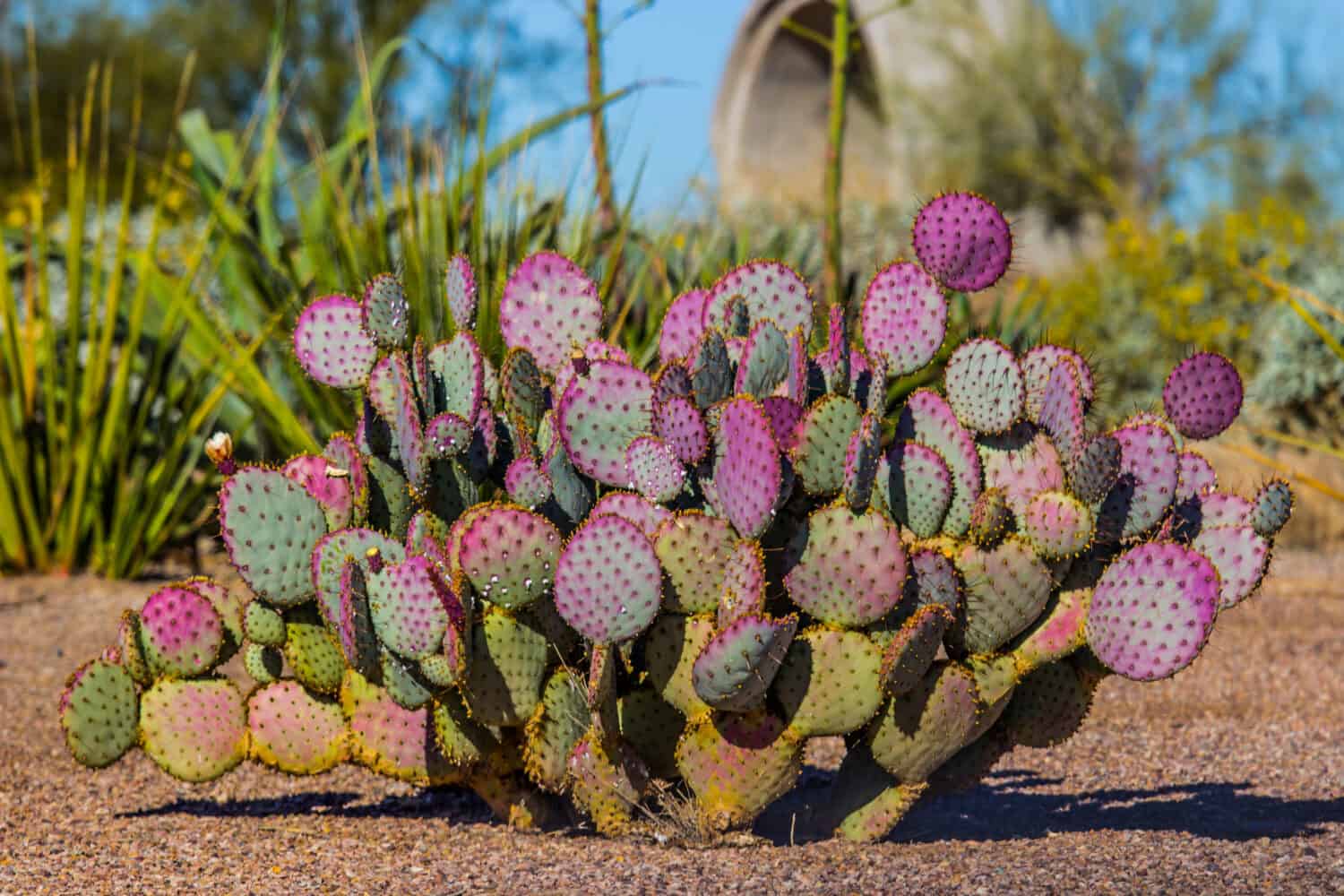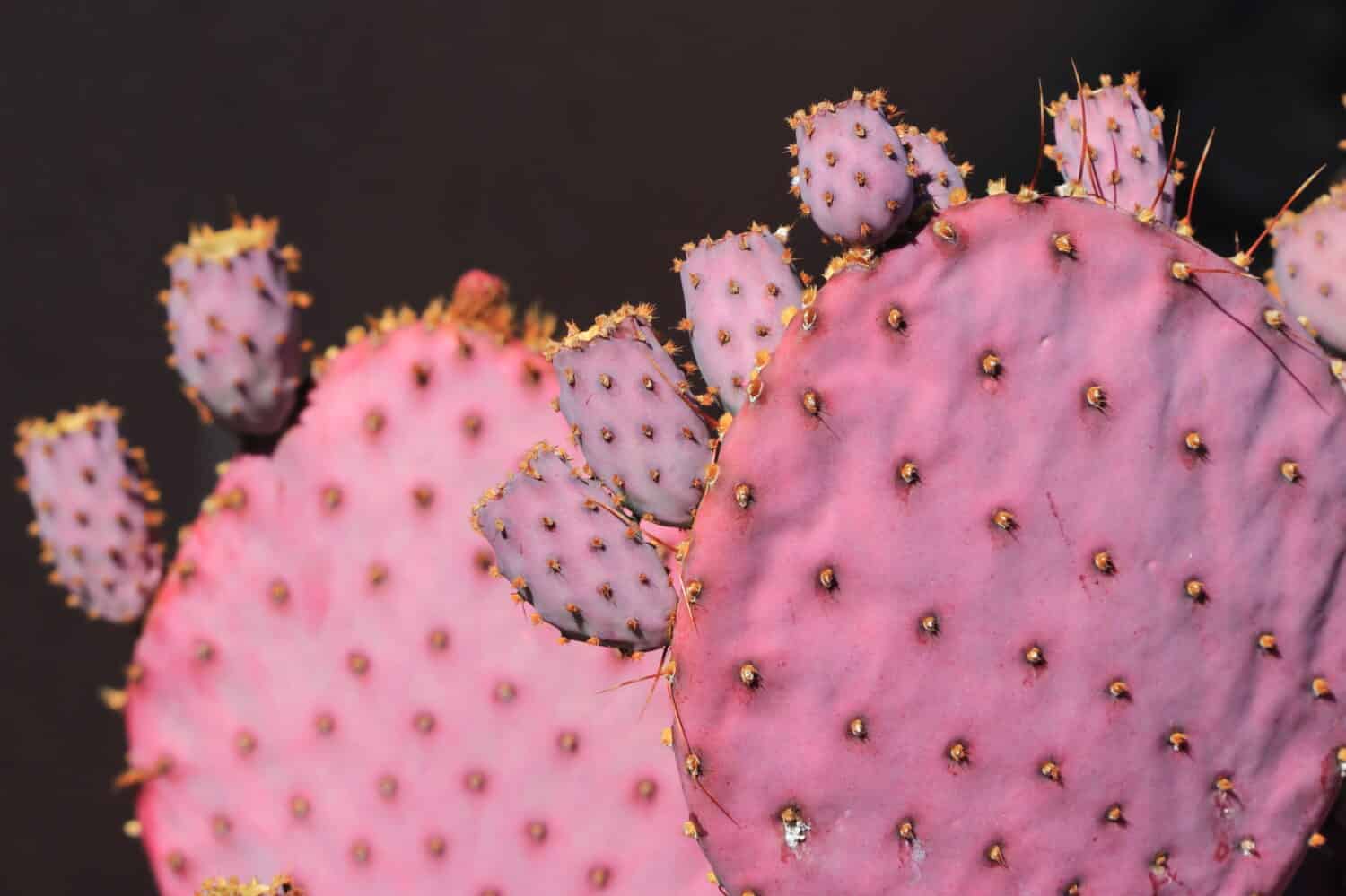Have you ever tasted a delicious prickly pear fruit? These edible fruits grow on cacti and they are very refreshing and nutritious. You can find these small round fruits on plants like the purple prickly pear cactus. Did you know you can also grow your prickly pear cacti, with the right conditions? Follow along to learn all about the purple prickly pear cactus including how to care for the plant.
What is a Purple Prickly Pear Cactus?
A purple prickly pear cactus is a beautiful cactus native to the lower Southwestern United States and Northwestern Mexico. While they are more common in Mexico, you can also find these plants growing wild in Arizona, New Mexico, and Southwestern Texas. The scientific name for this plant is Opuntia macrocentra. Sometimes it’s also called the long-spined purplish prickly pear. As the name suggests, the purple prickly pear plant has long spikes on its pads and purple coloration. The shade of purple though varies.
Purple prickly pear cacti are tall shrubs that spread quickly. The pads are joined together and continue growing on top of one another. Typically, this plant reaches about 1 to 2 feet tall, however, they can have been recorded as tall as 1 yard.
The pads on this plant are large and smooth. They can grow up to 8 inches long and wide. However, purple prickly pads are typically wider than they are longer. Long spines grow on the upper half of the prickly pear pad. They are about 2 to 3 inches long and grow in clumps. For instance, you can find multiple spines in one aerole.

Purple prickly pear cacti are native to the lower Southwestern United States and Northwestern Mexico.
©ThomasPhoto/Shutterstock.com
The Colors of a Purple Prickly Pear
Purple prickly pear cacti aren’t just purple. The stems, for instance, are typically pale green or grey-blue. Sometimes, they have a light purple tinge. The pads are what most people go crazy for. Purple prickly pear pads are green, pink, and purple. However, they are more intense in the upper half. The purple coloration though isn’t always evident. The plant becomes more purple when the temperature drops or they are stressed. It’s common to find vibrant prickly pear plants during droughts.
Purple prickly pear cacti also produce large and eye-catching yellow and red flowers. While most of the flower is yellow, the inner parts are deep red. From these flowers, small edible fruits are produced. The fruits range in color but are usually green, red, or purple.
When Will My Purple Prickly Pear Cactus Bloom?
Many people grow prickly pear cacti as ornamental or decorative plants because of their bright flowers. The flowers typically bloom in late spring and early summer. They are about 2 inches long. Purple prickly pear flowers open during the day and close at night.

Purple prickly pear cacti produce beautiful yellow and red flowers. They bloom in early spring through summer.
©Bill Florence/Shutterstock.com
How to Care for a Purple Prickly Pear
Now that we know a little more about this cactus, we can dive into how to grow and care for it. The purple prickly pear cactus is easy and low-maintenance. Although you can grow prickly pear plants in containers, they spread quickly and can develop root rot and other diseases easier. It’s best to grow purple prickly pear cacti in warm and sunny environments that mimic their native range. Follow along to learn how to care for prickly pear cacti.
Light
Purple prickly pear cacti are resilient plants. They thrive in warm and dry conditions. When planting outdoors, choose a spot where your purple prickly pear plant receives full sunlight. Although you can grow this plant indoors with the right amount of sunlight and water, it won’t grow as big.
Water
Purple prickly pear cacti don’t need a lot of water. They are low-maintenance cacti that suffer from too much water. The pads on a purple prickly plant become more purple when the plant is deprived of water. Typically, rainfall provides enough water for purple prickly pear plants. However, if you’re experiencing a drought, you can water your cactus twice a month in summer and once a month the rest of the year.
Nutrients
Do purple prickly pear cacti need nutrients or additional fertilizer? Usually, these plants don’t require additional nutrients. They can pull nutrients from the soil. However, you can purchase a cactus-friendly fertilizer in stores and use it during its growing season. Fertilizers can help produce more flowers and fruit.
Soil
It’s important to choose the right soil when caring for a purple prickly pear cactus. Not just any potting soil will do. This plant thrives in well-draining alkaline to neutral soil. If the soil is too wet or retains water, it can lead to root rot, which slowly kills your plant. Root rot also introduces pests to your plant because of added moisture. Sandy soil is best for prickly pear cacti as it’s strong enough to hold them upright and is similar to the soil in their native range.
Pests and Diseases
Luckily, these plants are strong and resilient against pests. There aren’t many critters that will attack mature prickly pear plants. The biggest problem that these plants face is root rot. This occurs when the roots don’t get enough oxygen, typically because they are drowning in water. It’s more common in plants in containers. If you’re growing your prickly pear in a container, choose one with drainage holes at the bottom. Also, remove any trays that allow water to sit.
While not as common as root rot, some insects, like the cochineal scale, can inflict damage. They suck the sap out of the plant. These tiny insects are common in the southwestern United States. They reproduce quickly and can take over large sections of cacti in just a few days. When getting rid of cochineal scales, wear gloves so you don’t jab yourself with the plant’s spines. The best way to get rid of these scales is by blasting them with water or killing them with an alcohol swab or cotton ball.
How to Propagate Purple Prickly Pear Cacti
Purple prickly pear cacti are favorites for a reason. They have many uses and produce delicious and edible fruits that can be eaten raw or made into a drink. If you’re looking to add more color to your garden and you already have a purple prickly pear plant, you can always propagate it to create more. However, it’s not an overnight process and requires time.
When taking a cutting of this plant (a pad), you’ll need to wear thick heavy-duty gloves to protect yourself from the spines. Gently, snap a mature oval pad. It’s easier to select from the top growth. When choosing, look for pads that are pest and disease free. It’s also important you don’t choose a prickly pad with flowers. The plant’s energy is directed to growing and blooming the flower, making it harder to develop roots. If the cutting doesn’t twist right off, you can use a clean knife. Repeat 2 to 3 times to get a few pads, just in case some don’t form roots.
Place the pads on dry paper towels so that the wound heals. When it’s dry, you can dip the callus, or ‘wound’ into rooting hormone powder. This isn’t necessary though as prickly pear plants produce roots without hormones. After your cuttings are ready, prepare cactus soil in a container and place the callus side into the soil. Water the soil well and leave it alone for a few weeks. During these few weeks, the plant only needs partial sun. Too much can damage the fragile pad. To test if it’s rooted, wiggle the pad, you can feel the resistance.

It can take months to propagate a prickly pear cactus.
©William Hunton/Shutterstock.com
Thank you for reading! Have some feedback for us? Contact the AZ Animals editorial team.








